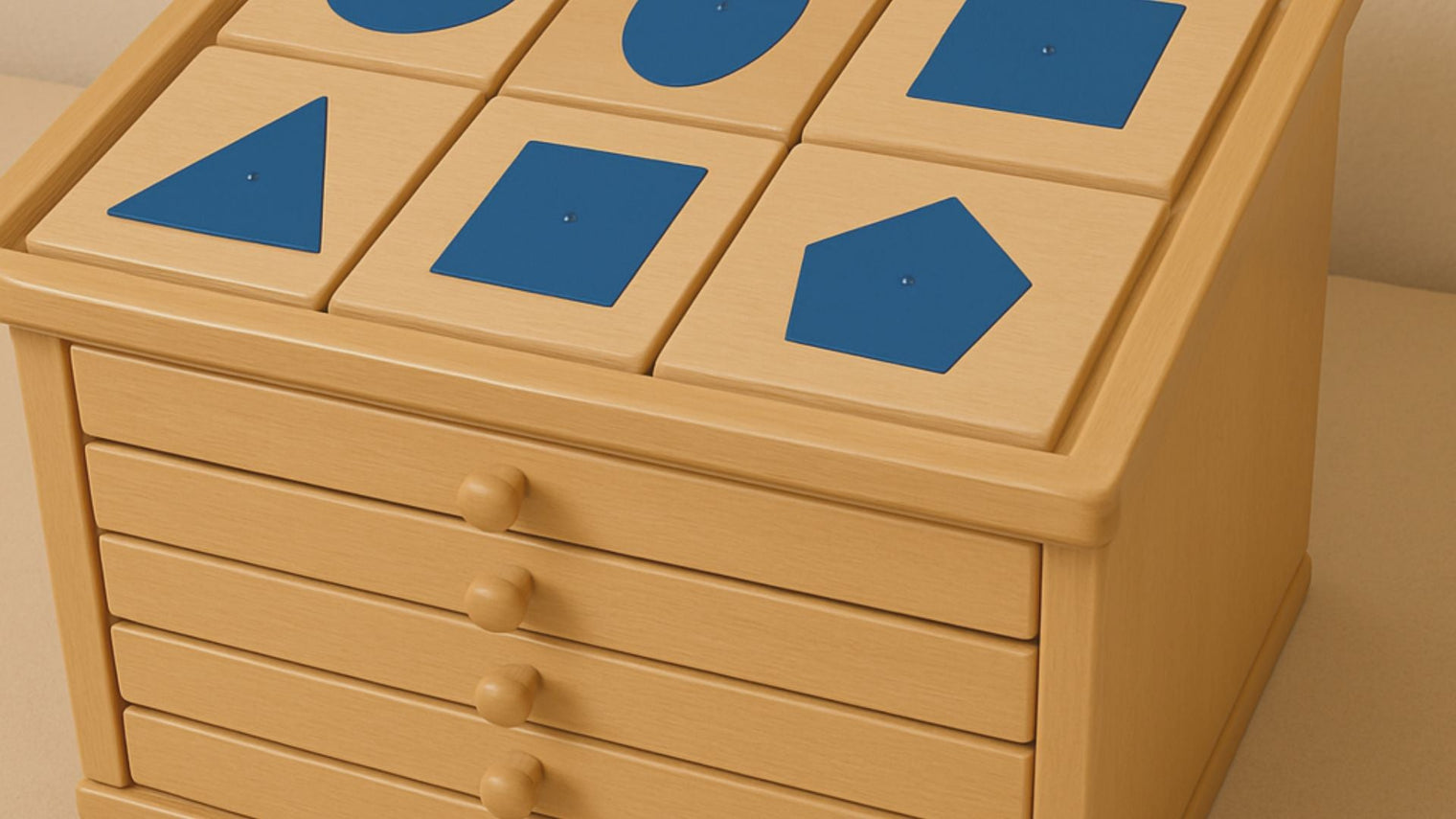When it comes to hands-on learning, few tools embody the Montessori philosophy as beautifully as the Montessori Geometric Cabinet.
Designed to nurture a child’s understanding of shapes, dimensions, and spatial awareness, this timeless material does far more than teach geometry—it builds focus, order, and curiosity.
At Dannico Woodworks, we believe children learn best when they can touch, explore, and discover for themselves.
That’s why our handcrafted Montessori-inspired pieces are designed with both function and development in mind.
Understanding how to use the Geometric Cabinet can help you unlock your child’s natural love for learning—and bring Montessori principles to life right in your home or classroom.
Benefits of the Montessori Geometric Cabinet
Fosters Independence and Concentration
One of the key principles of Montessori education is fostering independence. The geometric cabinet encourages children to work independently, selecting shapes and exploring them at their own pace.
This process helps build concentration and focus, essential skills that will benefit them throughout their educational journey.
Enhances Spatial Awareness
As children handle and manipulate the geometric shapes, they develop a stronger sense of spatial awareness.
Understanding how shapes fit together and relate to one another is a foundational skill that can be applied to more complex mathematical and scientific concepts.
Develops Fine Motor Skills

The small knobs on each shape require a pincer grasp, similar to holding a pencil, which strengthens the muscles needed for writing.
How to Introduce the Geometric Cabinet to Your Child
Start with an Invitation
Invite your child to explore the geometric cabinet with you. Present it as a special activity that they can engage in independently or with your guidance.
By framing it as an invitation, you encourage a sense of curiosity and excitement about the learning experience.
Demonstrate the Process
Begin by demonstrating how to carefully remove a shape from the cabinet and place it back into its corresponding slot.
Show your child how to handle the shapes gently and explain the importance of treating the materials with respect.
Encourage Exploration
Allow your child to explore the cabinet at their own pace.
They may start by simply removing and replacing shapes, but over time, they will begin to notice patterns and relationships between the different geometric figures.
Encourage them to explore these relationships and ask questions about what they observe.
Introduce New Concepts
Once your child is comfortable with the basic shapes, you can introduce new concepts such as congruence, similarity, and symmetry.
Use the geometric shapes to demonstrate these ideas in a tangible way, making abstract concepts more accessible.
Activities to Enhance Learning with the Geometric cabinet
Sorting and Matching
Challenge your child to sort the geometric shapes by different attributes, such as size or type.
They can also match shapes that are similar but differ in size, reinforcing their understanding of geometric properties.
Shape Tracing
Provide your child with paper and crayons to trace the shapes. This activity not only reinforces their recognition of geometric figures but also helps develop their writing skills. Encourage them to label each shape as they trace it.
Shape Hunt
Take the learning experience beyond the classroom by going on a shape hunt. Ask your child to find objects around the house or in nature that match the shapes they have been exploring in the cabinet.
This activity helps them see the practical applications of their learning in the world around them.
Caring for Your Montessori Geometric Cabinet
To ensure the longevity of your geometric cabinet, it's important to care for it properly. Regularly dust the cabinet and shapes to keep them clean.
If the wooden surfaces become dry, consider applying a natural wood conditioner to maintain their beauty and integrity.
Involving your child in the care of the cabinet can also be a valuable learning experience.
Teach them how to handle the shapes gently and return them to their rightful place after use, instilling a sense of responsibility and respect for their learning materials.
Benefits of Using the Montessori Geometric Cabinet
The benefits go far beyond geometry—they touch nearly every area of development:
-
Cognitive Growth: Children learn classification, comparison, and reasoning.
-
Fine Motor Skills: Handling and fitting the shapes strengthens the pincer grasp and hand-eye coordination.
-
Language Development: Introducing shape names expands vocabulary and comprehension.
-
Concentration and Order: Repetition fosters patience, precision, and focus—core Montessori values.
-
Foundation for Mathematics: These early sensorial impressions prepare children for abstract concepts in geometry, fractions, and measurement later on.
Tips for Parents Using the Geometric Cabinet at Home
If you’re bringing Montessori principles into your home, here are a few helpful tips:
-
Keep the setup simple. Don’t overwhelm your child with all six drawers at once.
-
Use repetition, not correction. Let them learn through trial, error, and self-discovery.
-
Rotate materials. Refresh their interest by swapping drawers every few weeks.
-
Display attractively. At Dannico Woodworks, we believe beautifully designed materials encourage learning. Store your cabinet or shelves at your child’s level, where they can access them freely.
Explore our Montessori bookshelf collection to create a space that invites independent play and learning.
Integrating the Geometric Cabinet Into a Montessori Space
The Geometric Cabinet fits naturally into any Montessori-inspired environment. Pair it with:
-
A low Montessori bookshelf for easy access to other sensorial materials.
-
A soft, neutral workspace that promotes calm focus.
-
Complementary materials like the metal insets or geometry cards to extend lessons.
At Dannico Woodworks, each of our Montessori-inspired pieces is designed to support this kind of independence and purposeful exploration.
Every shelf, table, and learning station is thoughtfully built to grow with your child and nurture a lifelong love of learning.
FAQs
What age is best to introduce the Geometric Cabinet?
Most children are ready around age three or four, but it depends on their fine motor readiness and interest level.
How long should a session last?
Let your child guide the pace. Sessions typically last 10–20 minutes, but Montessori emphasizes quality over time—stop when your child’s focus begins to wane.
Do I need all six drawers right away?
Not necessarily. You can start with a simplified version and gradually expand. The key is progression and mastery at each level.
Can I use the Geometric Cabinet at home without formal Montessori training?
Absolutely. Montessori materials are designed for self-directed learning. With gentle guidance and observation, any parent can use them effectively.
Conclusion
The Montessori Geometric Cabinet is more than just a teaching tool—it’s an invitation for your child to explore the beauty of shape, order, and logic through their own hands.
It teaches far beyond geometry, laying the groundwork for confidence, curiosity, and a love for learning that lasts a lifetime.
At Dannico Woodworks, we craft furniture and learning tools that help families create environments where children can thrive—spaces that encourage independence, imagination, and joy.
Explore our collection of Montessori-inspired designs today at DannicoWoodworks.com and start building a learning space where your child can truly shine.
How will you inspire hands-on learning in your child’s environment today?

